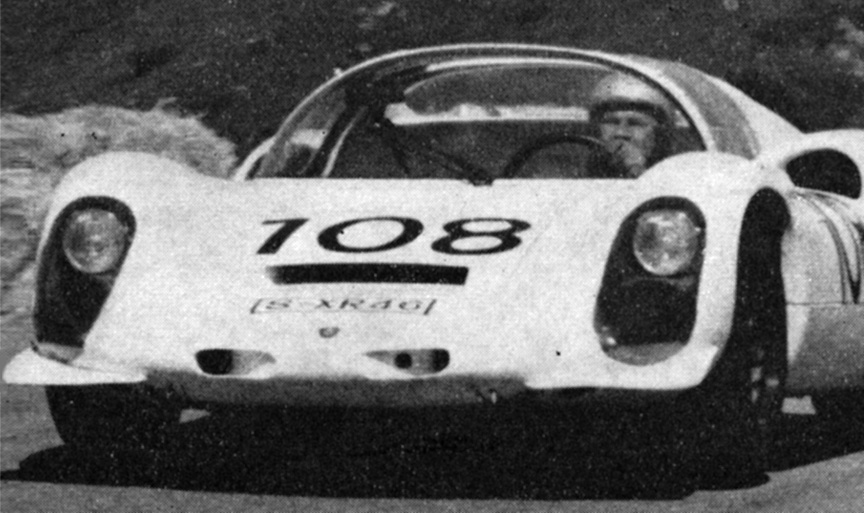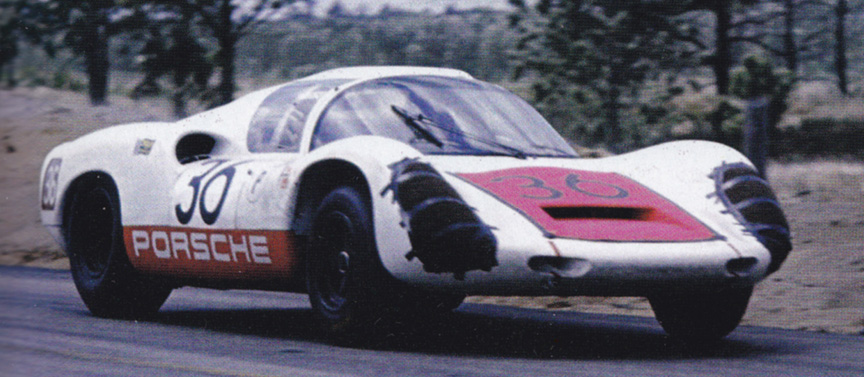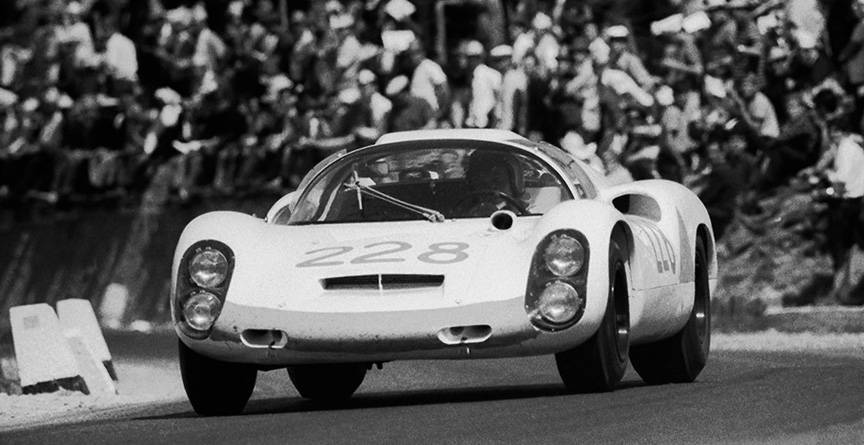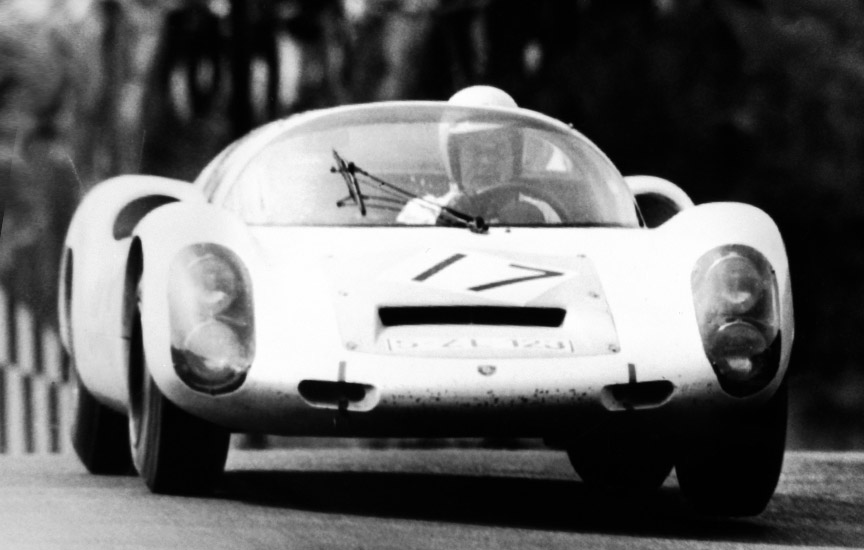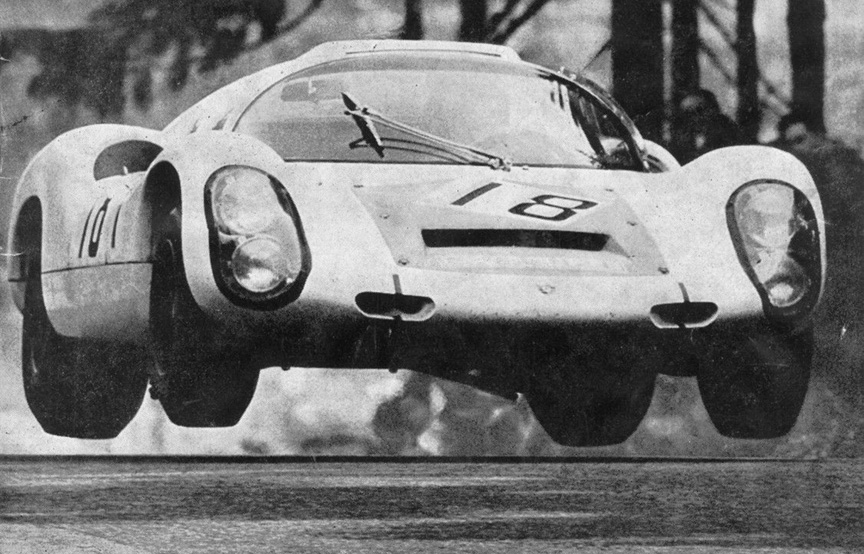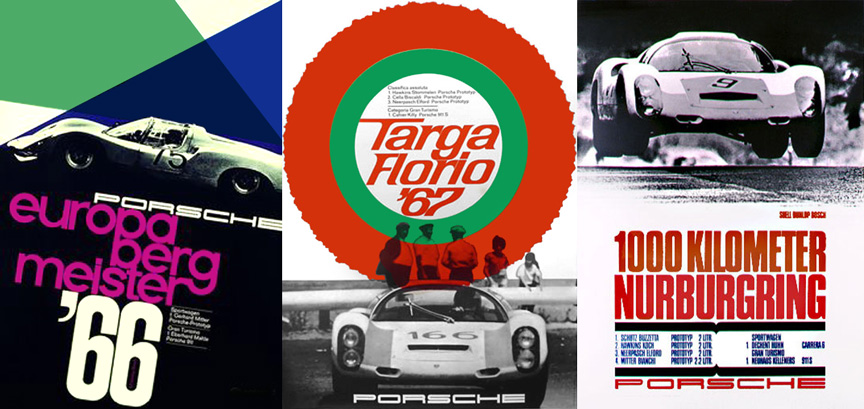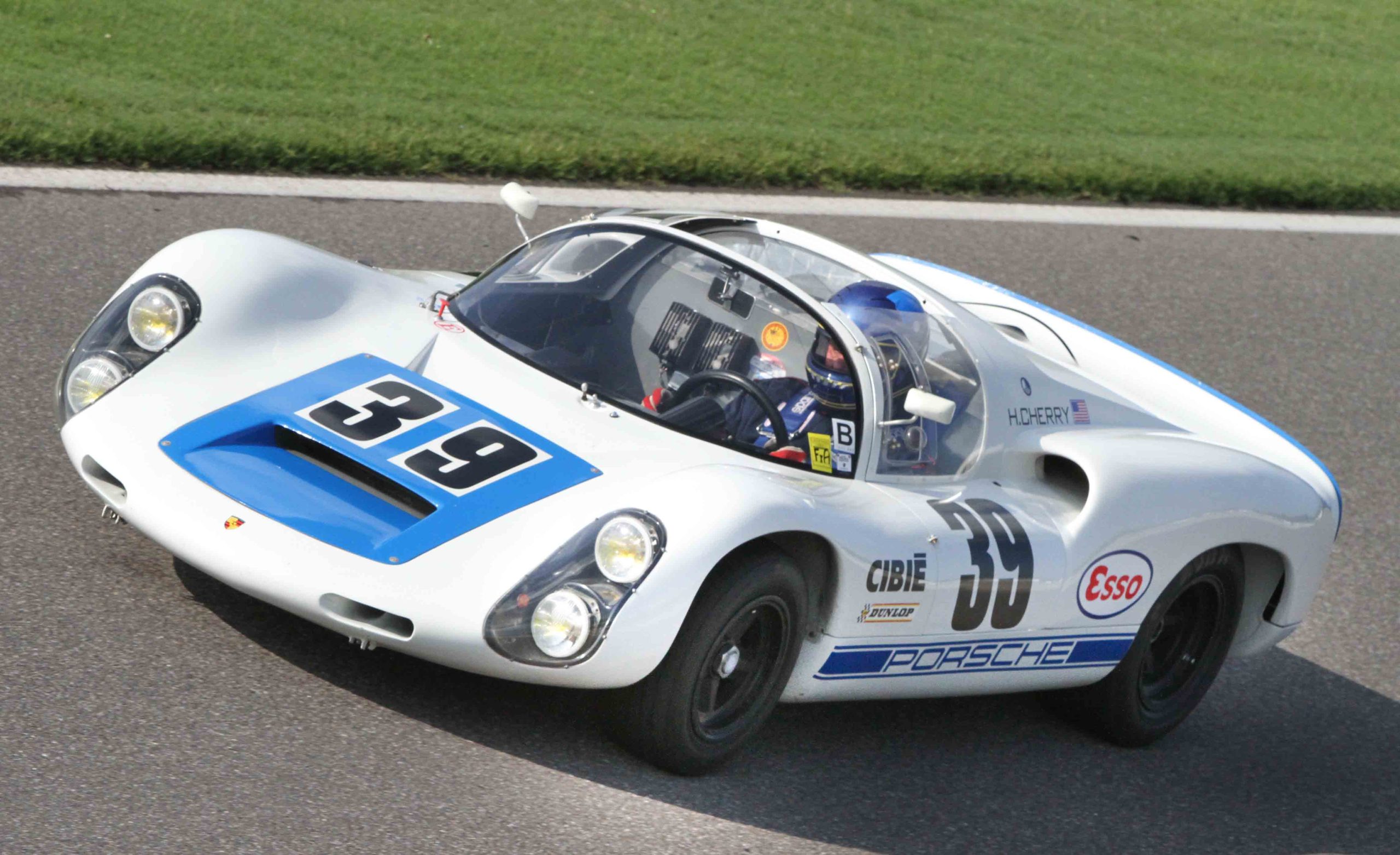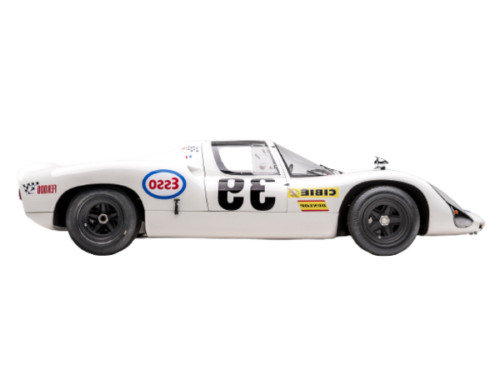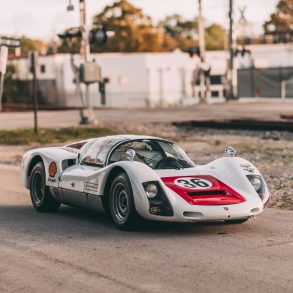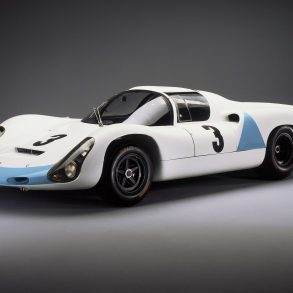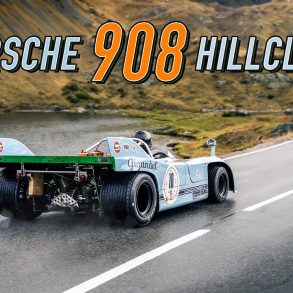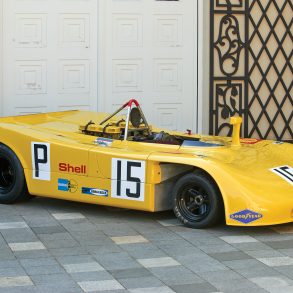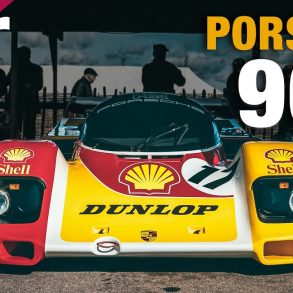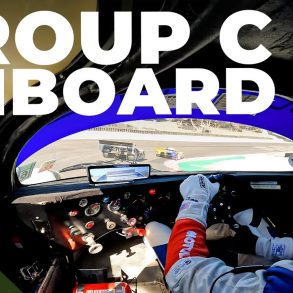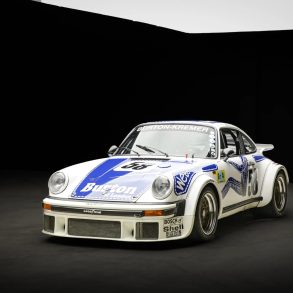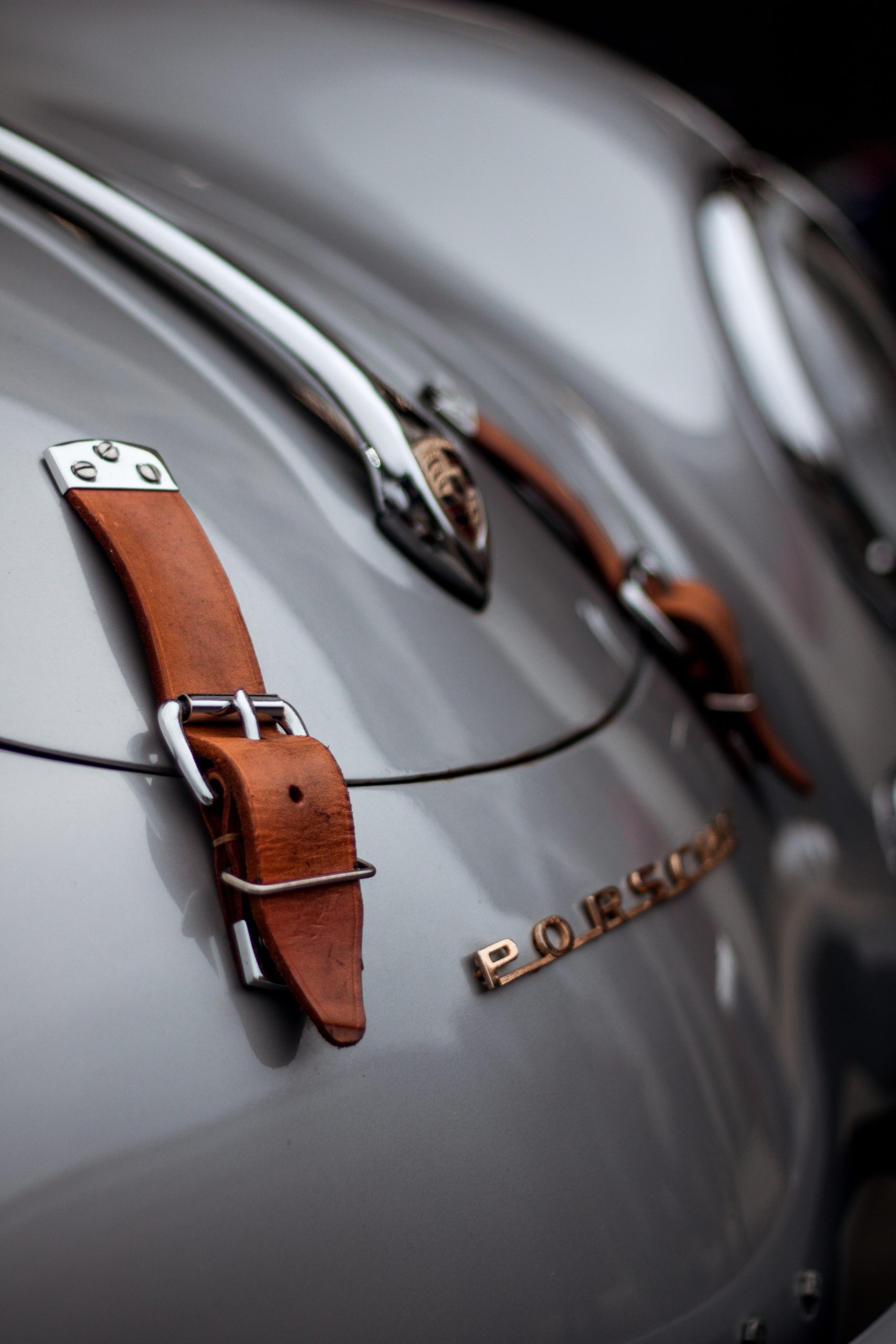Porsche 910 Targa (1967)
Premiere: 1966 July 10, Trento Bondone hill climb, Italy
Porsche 910 was the evolution of the 906 with Ferdinand Piëch as its main driving force and Hans Mezger as the head engineer. It came before 907, 908 and 909. Compared to the 906, the 910 had 13″ Formula 1 wheels with central locking (906 had 15″ 5-bolt wheels), more rounded design everywhere and the roof panel was removable. Because of the targa roof, the cool-looking gullwing doors of the 906 had to be forgotten. Manufacturing of the 910 Targa, 911 Targa and 912 Targa started more or less at the same time.
Already the prototype of the 906 had 13″ F1 wheels (906 Ollon-Villars), but the series 906 got 15″ wheels from 904. Then, for 1966 season, the 906 Ollon-Villars spyder (chassis 906-010) was converted to a coupé with removable roof panel. This 906-010 Targa became the prototype of the 910 as it had 13″ F1 wheels from day one and now also the targa roof concept not seen on Porsche racing cars before. The body design of the 906-010 Targa wasn’t exactly the same as on the series 910 Targa, but quite similar and the doors opened in the same way as on the real 910. The 906-010 Targa was first entered into the competition on June 12, 1966 at the Rossfeld-Berchtesgaden hill climb event in Germany. It was the 1st event of the 1966 European Hill Climb Championship (EHCC). The car was driven by Gerhard Mitter who finished first.
The “910” model name might have been derived from 906-010. The 13″ magnesium wheels were now Porsche items (and not from Lotus like on the 906 Ollon-Villars). 910 was quicker than 906 thanks to its Formula 1 tyres (higher cornering speeds), but the brakes had to be smaller because of the 13″ wheels. Quicker car with smaller brakes – it is a very good evidence of the mentality of the era, motorsport was for the brave ones.
The first real 910 (chassis number 910-001) debuted at the 3rd round of the 1966 EHCC at Bondone in Trento, Italy, on July 10, 1966. The 910 Targa was driven by Hans Herrmann who finished second after Gerhard Mitter in the 906-010 Targa.
The Cars
| 910/6 Targa | 910/8 Targa | |
|---|---|---|
| Engine | 2.0 flat-6 with fuel injection | 2.2 flat-8 |
| Engine type | Porsche type 901/21 | Porsche type 771/1 |
| Power | 162 kW (217 bhp) | 198 kW (265 bhp) |
| Gearbox | Type 906 5-speed manual with LSD | Type 906 5-speed manual with LSD |
The Story
A purpose built racing car, the Porsche Carrera 10, or 910, was designed specifically for international endurance racing. Based heaving on the Porsche 906, the 910 was produced and entered in 1966 and 1967. With the 910 considered to be the next sequence in the 906 line, the factory name for the 910 was the 906/10. The 910 differed from the original 906 with its use of 13-inch wheels and tires like in Formula One , and it was shorter and lighter which made it good competition for the more powerful GT40 and Ferrari prototypes. The 910 also featured a single large central nut rather than the 5 lugs in the 904 and 906’s, which made the racecar not street suitable, but it definitely saved time at pitstops. The Porsche 910 measured 161 inches in length, was 66 inches wide and 38 inches high.
Halfway through 1966 the Porsche 910 began to be entered, starting with the 1966 European Hill Climb Championship from Sierra to Crans-Montana in Switzerland. Powering the Porsche was either the dependable 2000 cc 6-cylinder the produced 200 hp or the 2200 cc 8-cylinder with up to 270 hp.
The factory only racing the 910 for about a year during which it was very successful. The 910’s main class rival was Ferrari Dino 206P which was quickly beaten. In 1967 at the 1000 km Nürburgring a fleet of 6 factory cars were entered in an effort by Porsche to score the first overall win in Porsche’s home event. Though two of the three 8-cylinder engines broke down, the remaining one finished 4th place. Giving Porsche their first outright win in a third major event of the World Sportscar Championship for Porsche, the three 6-cyl won 1-2-3. The new Porsche 907 ‘long tails’ was already entered in Le Mans and finished 5th in front of a 910 and two 906’s.
Designed for endurance racing, the Porsche 910 received its racing baptism and recorded its first success in the European Hillclimb Championship of 1966. The following year, the factory extensively campaigned the 910 in the world’s most prestigious endurance races, after which the car became available to privateers. Raced with both six- and eight-cylinder engines, the 910 proved competitive, recording outright victories in Sicily’s Targa Florio (910/8) and Germany’s 1000-Kilometers of Nurburgring where the 910/6 finished 1-2-3.
Although the 910 continued to be raced by privateers for several years, it was soon out-classed by the competition due to the rapid advances in technology. The high-water mark for 910 was 1967, when the car was raced exclusively by the Porsche factory.
Racing Results
The first victory for the 910 came on July 31 at the ADAC Bergpreis Freiburg-Schauinsland (1966 EHCC 5th race). The winning car, #75 910-002, was driven by Gerhard Mitter. In 1966, 910 (chassis 001 and 002) saw action only at hill climb events. Gerhard Mitter became the European Hill Climb Champion in 1966. To win this championship he used the 906-010 Targa, but also the new 910 Targa.
The first race in 1967 was the Daytona 24 hours in Florida where one 910 was entered with Hans Hermann/Jo Siffert and this #52 910-003 scored 4th overall after 4-litre Ferraris. Two months later, at the 1967 Sebring 12 hours, factory team entered two 910 (chassis 004 and 005) and they did really well again. The two 7-litre GT40s were followed by two 2-litre 910s. The third place 910 #36 (chassis 005, Gerhard Mitter/Scooter Patrick) finished on the same lap with the second place GT40. This was the ultimate proof of Porsche’s sophistication: Ford needed 7-litre engines to beat 2-litre Porsches.
In Europe the season started later and 910 did well. On April 25 at the Monza 1000 km race the 910-008 #15 was driven by Gerhard Mitter/Jochen Rindt to 2-litre class victory and 3rd overall after 4-litre Ferraris. A week later at the Spa 1000 km, the 910-007 #21 driven by Jo Siffert/Hans Herrmann scores 2nd overall after a GT40.
Then, at the Targa Florio on May 14, 1967, nothing was left for chance – Ferdinand Piëch and Porsche factory team arrived with 7 (!) 910, one for practising/backup and 6 for participation. For the first time also 910s with 2.2-litre 8-cylinder engines were used (this was not the first 2.2-litre Porsche, one 906 with such engine had been made a year earlier). As a result, Porsche took all the podium places:
- 910/8 2.2 #228, chassis no. 910-024, Rolf Stommelen/Paul Hawkins
- 910/6 2.0 #174, chassis no. 910-015, Leo Cella/Giampiero Biscaldi
- 910/6 2.0 #166, chassis no. 910-014, Vic Elford/Jochen Neerpasch
Porsche proved that it can do better than the 1-2-3 victory and just two weeks after the 1967 Targa Florio they took the 1-2-3-4 victory with 910s at the Nürburgring 1000 km race. Piëch, just at the age of 30, was about to become the king of racing technology.
Next race in the calendar was the 24 hours of Le Mans, but Ferdinand Piëch’s team had another Porsche prototype ready for this event – the 907. So, the focus on 910 started to decrease. The 1967 Targa Florio and Nürburgring 1000 km race remained the only ones where overall victory was achieved with 910 Targa, but more podiums followed. On July 23, 1967, the Mugello 500 km race was won by two 910/8 with their 2.2-litre engines: 1st #1 910-025 Udo Schütz/Gerhard Mitter, 2nd #2 910-023 Jochen Neerpasch/Rolf Stommelen. Third place in this race was taken by a 911 R showing it was not a very important race. Another podium came at the Brands Hatch 6 hour race on July 30, 1967, when Bruce McLaren/Jo Siffert scored 3rd overall in a factory entered 2.2-litre 910/8 #11 (chassis 028), behind a 7-litre Chaparral and a 4-litre Ferrari.
The originally 8-cylinder 910s were fitted with 6-cylinder engines and sold to private teams. At the 1967 Linas-Montlhéry Paris 1000 km in a strong competition factory drivers Hans Herrmann/Udo Schütz scored 3rd with the privately entered 910-023 (now with the 6-cylinder engine). Private teams continued to earn more fame for the 910 with places II and III at the 1968 Barcelona 6 hour race, 3rd at the the 1969 Vila Real 6 hours and elsewhere.
